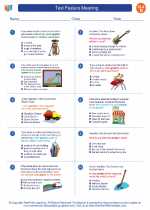Text Feature Meaning
Text features include all the components of a story or article that are not the main body of text.
◂English Language Arts Worksheets and Study Guides Fourth Grade. Text Feature Meaning
Worksheet/Answer key Text Feature Meaning
Text Feature Meaning  Worksheet/Answer key
Worksheet/Answer key Text Feature Meaning
Text Feature Meaning  Worksheet/Answer key
Worksheet/Answer key Text Feature Meaning
Text Feature Meaning 

 Worksheet/Answer key
Worksheet/Answer key
 Worksheet/Answer key
Worksheet/Answer key

The resources above cover the following skills:
General Reading Processes
Students will use a variety of strategies and opportunities to understand word meaning and to increase vocabulary.
Understand, acquire, and use new vocabulary
Use context to determine the meanings of words
Students will use a variety of strategies to understand what they read (construct meaning).
Use strategies to prepare for reading (before reading)
Survey and preview the text by examining features such as the title, illustrations, photographs, charts, and graphs
Comprehension of Informational Text
Develop comprehension skills by reading a variety of self-selected and assigned print and non-print informational texts, including electronic media
Read, use, and identify the characteristics of functional documents such as sets of directions, science investigations, atlases, posters, flyers, forms, instructional manuals, menus, pamphlets, rules, invitations, recipes, advertisements, other functional documents
Identify and use text features to facilitate understanding of informational texts
Use print features such as large bold print, font size/type, italics, colored print, quotation marks, underlining, and other print features encountered in informational texts
Use graphic aids such as illustrations and pictures, photographs, drawings, sketches, cartoons, maps (key, scale, legend, graphs, charts/tables, and diagrams, other graphic aids encountered in informational texts
Use informational aids such as introductions and overviews, materials lists, timelines, captions, glossed words, labels, numbered steps, bulleted lists, footnoted words, pronunciation key, transition words, boxed text
Use organizational aids such as titles, chapter titles, headings, subheadings, tables of contents, numbered steps, glossaries, indices, transition words
Identify and explain the contributions of text features to meaning
Read critically to evaluate informational text
Identify and explain additions or changes to format or text features that would make the text easier to understand
Comprehension of Literary Text
Use text features to facilitate understanding of literary texts
Identify and explain how organizational aids such as the title of the book, story, poem, or play contribute to meaning
Identify and explain how graphic aids such as pictures and illustrations, punctuation, print features contribute to meaning
Identify and explain how informational aids such as introductions and overviews, materials lists, timelines, captions, glossed words, labels, numbered steps, bulleted lists, footnoted words, pronunciation keys, transition words, end notes, works cited, other information aids encountered in informational texts contribute to meaning
Identify and explain how print features such as large bold print, font size/type, italics, colored print, quotation marks, underlining, other print features encountered in informational texts contribute to meaning
Controlling Language
Apply conventional spelling in written language
Modify spellings when adding inflectional endings and suffixes